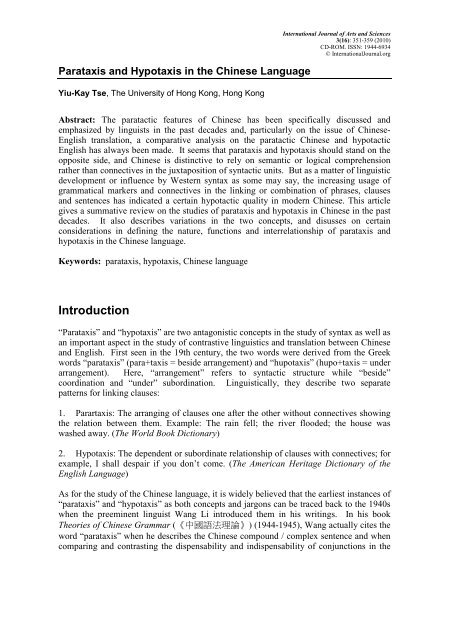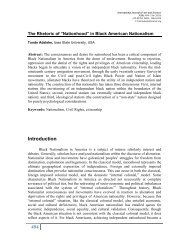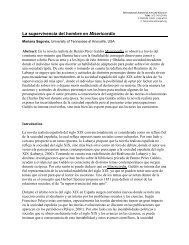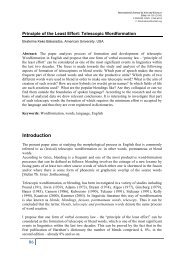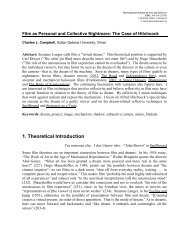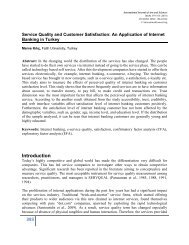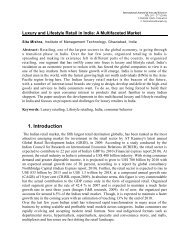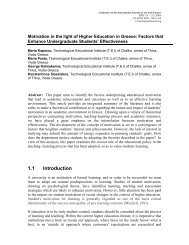IJTM/IJCEE PAGE TEMPLATEv2
IJTM/IJCEE PAGE TEMPLATEv2
IJTM/IJCEE PAGE TEMPLATEv2
You also want an ePaper? Increase the reach of your titles
YUMPU automatically turns print PDFs into web optimized ePapers that Google loves.
Parataxis and Hypotaxis in the Chinese Language<br />
Yiu-Kay Tse, The University of Hong Kong, Hong Kong<br />
International Journal of Arts and Sciences<br />
3(16): 351-359 (2010)<br />
CD-ROM. ISSN: 1944-6934<br />
© InternationalJournal.org<br />
Abstract: The paratactic features of Chinese has been specifically discussed and<br />
emphasized by linguists in the past decades and, particularly on the issue of Chinese-<br />
English translation, a comparative analysis on the paratactic Chinese and hypotactic<br />
English has always been made. It seems that parataxis and hypotaxis should stand on the<br />
opposite side, and Chinese is distinctive to rely on semantic or logical comprehension<br />
rather than connectives in the juxtaposition of syntactic units. But as a matter of linguistic<br />
development or influence by Western syntax as some may say, the increasing usage of<br />
grammatical markers and connectives in the linking or combination of phrases, clauses<br />
and sentences has indicated a certain hypotactic quality in modern Chinese. This article<br />
gives a summative review on the studies of parataxis and hypotaxis in Chinese in the past<br />
decades. It also describes variations in the two concepts, and disusses on certain<br />
considerations in defining the nature, functions and interrelationship of parataxis and<br />
hypotaxis in the Chinese language.<br />
Keywords: parataxis, hypotaxis, Chinese language<br />
Introduction<br />
“Parataxis” and “hypotaxis” are two antagonistic concepts in the study of syntax as well as<br />
an important aspect in the study of contrastive linguistics and translation between Chinese<br />
and English. First seen in the 19th century, the two words were derived from the Greek<br />
words “parataxis” (para+taxis = beside arrangement) and “hupotaxis” (hupo+taxis = under<br />
arrangement). Here, “arrangement” refers to syntactic structure while “beside”<br />
coordination and “under” subordination. Linguistically, they describe two separate<br />
patterns for linking clauses:<br />
1. Parartaxis: The arranging of clauses one after the other without connectives showing<br />
the relation between them. Example: The rain fell; the river flooded; the house was<br />
washed away. (The World Book Dictionary)<br />
2. Hypotaxis: The dependent or subordinate relationship of clauses with connectives; for<br />
example, I shall despair if you don’t come. (The American Heritage Dictionary of the<br />
English Language)<br />
As for the study of the Chinese language, it is widely believed that the earliest instances of<br />
“parataxis” and “hypotaxis” as both concepts and jargons can be traced back to the 1940s<br />
when the preeminent linguist Wang Li introduced them in his writings. In his book<br />
Theories of Chinese Grammar (《中國語法理論》) (1944-1945), Wang actually cites the<br />
word “parataxis” when he describes the Chinese compound / complex sentence and when<br />
comparing and contrasting the dispensability and indispensability of conjunctions in the
paratactic Chinese language and the hypotactic English language. In his later book An<br />
Essential Chinese Grammar (《中國語法綱要》) (1946), Wang again mentions “yihe fa<br />
意合法”, or “parataxis”, when referring to linking clauses in the Chinese language.<br />
In the beginning, references to “parataxis” in Chinese were primarily meant for<br />
contrasting it with hypotaxis in English in relation to the use of conjunctions in linking<br />
clauses. More specifically, it is a norm for conjunctions to be dropped while the contrary<br />
is true in English. Soon, the theory that Chinese is “paratactic” while English is<br />
“hypotactic” became widely established. With the development of Chinese grammar,<br />
there has been a strong tendency among scholars to tailor-make a system independent of<br />
the Western framework for truly describing the unique Chinese language. This same goal<br />
has also spurred zealous efforts to uncover the characteristics of Chinese in contrast with<br />
other languages. Unlike Indo-European languages, there is an absence of complex<br />
positional variation, declension and inflection in the Chinese language. This is why the<br />
combination of Chinese words is governed by semantics rather than inflection. Whether it<br />
is the combination of morphemes to form words, combination of words to form phrases,<br />
combination of clauses to form composite sentences or combination of sentences to form<br />
clusters, the rule lies not so much in explicit grammar but in implicit semantics. So long<br />
as it makes sense semantically and logically, syntactic units can be joined together. This<br />
paratactic quality characteristic of the Chinese language is made all the more prominent in<br />
comparison with the hypotactic English language and hence has attracted much more<br />
attention from scholars in the past three decades.<br />
Variations in Concepts<br />
Decades ago, it was in the context of combining clauses in a compound or complex<br />
sentence that Wang Li mentioned parataxis and hypotaxis. Nowadays, after much study<br />
and analysis, the definitions and connotations of parataxis and hypotaxis in relation to the<br />
Chinese language seem to have far exceeded what they mean in the study of linguistics in<br />
the West. This is seen largely in:<br />
1. Nature of combination: This has been extended from “linking” to cover<br />
“construction” or even “organization”;<br />
2. Target of combination: Instead of confining to clauses, the combination can be<br />
syntactical (including words, phrases, clauses and sentences), morphological (including<br />
combining morphemes to form compound words and the formation of abbreviations) and<br />
even textual (including combination of paragraphs);<br />
3. Paratactic devices: In addition to conjunctions, the devices can be syntactic (e.g.<br />
using connectives including conjunctions, adverbs, prepositions and any other word or<br />
phrase serving the same purpose), inflective (e.g. using auxiliary words like “men 們” to<br />
denote plurals, “liao 了, zhe 著 and guo 過” to denote tense or “de 的, de 地 and de 得” to<br />
respectively denote attributes, adverbials and complements), lexical (e.g. using affixes and
epetition) or at the discourse level (e.g. logical arrangement and textual linking); and<br />
4. Scope of application: In the area of grammar, the focus is on not only if paratactic<br />
devices are used but also if the sentence structure is complete or not (probably incomplete<br />
in the case of parataxis and complete in the case of hypotaxis). Apart from grammar, the<br />
same can also be applied to philology (as in the paratactic formation of pictograms [象形<br />
字], ideograms [指事字], radical-radical compounds [會意字] and even the picto-radicals<br />
of radical-phonetic compounds [ 形聲字]), lexis (as in looking into the semantic<br />
relationships involved in the paratactic formation of words that are apparently illogical,<br />
e.g. “jiuhuo 救火 [to save + fire], yaobin 養病 [to nurture + illness], kaidao 開刀 [to open<br />
+ knife], xiemu 謝幕 [to thank + curtain], huifu pilao 恢復疲勞 [to restore + fatigue],<br />
dasao weisheng 打掃衛生 [to clean + hygiene] ”) and rhetoric (e.g. paratactic rhetorical<br />
functions and effects).<br />
The phenomenon of stretching parataxis and hypotaxis beyond syntactic linking in the<br />
Chinese language may have much to do with a growing aspiration to describe the<br />
characteristics of Chinese as a language. Telltale signs can be gathered from the studies of<br />
parataxis and hypotaxis in multifarious perspectives and with different foci in the past<br />
decades:<br />
1. Perspectives: These range from the cultural traits (like preferences for “yi 意”, or<br />
idea, and “shen 神 ”, or spirit) common in Chinese traditional arts (like painting,<br />
calligraphy and operas) through Chinese philosophies and thoughts (like “tianren heyi 天<br />
人合一”, or heaven and man as one, and “zhengtiguan 整體觀”, or integrality) to Chinese<br />
paratactic combinations (like combinations of morphemes and words, syntactic patterns<br />
[e.g. verb-object constructions] and discourse organization) and Chinese pragmatics (like<br />
the selective use of paratactic and hypotactic expressions in different contexts and genres);<br />
and<br />
2. Foci: (a) The paratactic phenomena and hypotactic devices at various linguistic levels<br />
in the Chinese language. (b) The causes leading to the preference for parataxis in Chinese<br />
and for hypotaxis in English: There are two major types of causes. The first is linguistic<br />
and stems from the disparate nature of the two languages. Here are some examples. First,<br />
while Chinese is a topic-prominent language that depends on a topic-comment structure<br />
for syntactic construction, English is a subject-prominent language where the sentence<br />
requires strict subject-verb concordance. Second, while Chinese is a semantic language<br />
that emphasizes coherence in meaning, English is an inflective language that emphasizes<br />
cohesion in form. Third, while Chinese is a diffusive, inflection-free language where the<br />
clauses, joined together or otherwise, are arranged as the ideas emerge in a natural and<br />
seemingly arbitrary flow like a stream of water, English is a compact language where the<br />
subject-predicate structure can be compared to the trunk of a tree from which clauses<br />
branch out. So much for the examples. As for the second type of causes, it is cognitive<br />
and hinges on culture, modes of thinking, habits, philosophical beliefs and aesthetics. (c)<br />
Other qualities that are closely related to the paratactic character of the Chinese language,
such as conciseness (i.e. linguistic components can be omitted so long as the main idea<br />
can get across) and flexibility (i.e. there is no fixed correspondence between parts of<br />
speech and syntactic components; the same word can function as different syntactic<br />
components; and collocation is fluid).<br />
Some scholars have even stretched parataxis and paratactic qualities beyond syntactic<br />
patterns in their attempts to devise a “paratactic grammar” grounded in semantic syntax<br />
where combination of linguistic units is governed by semantics. While the feasibility of<br />
such a system is still being disputed, there is no doubt that the study of parataxis and<br />
hypotaxis has contributed much to the understanding of the characteristics of the Chinese<br />
language as well as the contrastive qualities and translation between Chinese and English.<br />
The value of such studies will become even greater once certain important concepts<br />
become clearly defined. In this respect, there are two main issues to be discussed<br />
respectively in the following sections.<br />
Paratactic Device or Hypotactic Device?<br />
Whether or not connectives are used when linking clauses is most commonly regarded as<br />
the defining marker of parataxis and hypotaxis. Connectives can be said to be a hypotactic<br />
device for explicitly showing the structural and semantic interrelationship between the<br />
components that are joined together. They are dispensed with in the case of parataxis,<br />
where the structural and semantic interrelationship between the joined components is<br />
understood through the flow of meanings. In light of the extended definitions and<br />
connotations of Chinese parataxis and hypotaxis, however, hypotactic devices are no<br />
longer confined to connectives. Take for example the linking of clauses. According to the<br />
latest theories, the absence of connectives between clauses does not necessarily mean<br />
hypotactic devices are non-existent altogether. For the sake of elaboration, let us revisit<br />
the antithetic structures that many scholars have cited to demonstrate the paratactic<br />
character of the Chinese language. In such constructions, symmetrical structure is<br />
employed for enhancing semantic contrast or correspondence. The first specimen I am<br />
citing is the juxtaposition of the nouns of “cocks’ crow (雞聲)”, “thatched tavern (茅店)”<br />
and “moon (月)” to form the line “雞聲茅店月” and that of “footprints (人跡)”, “slab<br />
bridge (板橋)” and “frost (霜)” to form “人跡板橋霜” in the poem Early Departure from<br />
Mount Shang (《商山早行》) by the Tang poet Wen Tingjun (溫庭筠) to emphasize the<br />
desolate scene and the lonesome man. The second specimen is the juxtaposition of the<br />
nouns of “withered vines (枯藤)”, “olden trees (老樹)” and “evening crows (昏鴉)” to<br />
form the line “枯藤老樹昏鴉”, that of “small bridge (小橋), “flowing brook (流水)” and<br />
“hamlets (人家)” to form “小橋流水人家”, and that of “ancient road (古道), “west wind (<br />
西風)” and “bony horse (瘦馬)” to form “古道西風瘦馬” in the poem Autumn Thoughts (<br />
《秋思》) by Ma Zhiyuan (馬致遠) of the Yuan dynasty to portray a dreary village in<br />
autumn. With the semantic and grammatical connection among the juxtaposed nouns left<br />
to the reader’s imagination, the thoughts and feelings conveyed by the imageries become<br />
open to interpretation. Linguistically speaking, the symmetry brought about by the<br />
parallel structures is conducive to semantic groupings and is hence sometimes considered
to be a paratactic device. Sometimes described as coordinate parataxis, coordinating<br />
clauses and sentences in such a way is often regarded as a pattern for semantic<br />
coordination.<br />
In fact, many scholars believe that, instead of relying on one single semantic device,<br />
which is parallel structure in this case, Chinese parataxis often takes supplementary<br />
devices like word order, repetition and condensation to achieve, and the list goes on.<br />
Now, let us go back to the use of connectives. In contrast to the English language where<br />
connectives are indispensable for linking clauses, connectives are optional in Chinese.<br />
When seen in the light of the above discussion, connectives can be said to be a formally<br />
explicit supplementary paratactic device in Chinese. How should we treat supplementary<br />
paratactic devices like parallel structure that are implicit rather than explicit then?<br />
Let me elaborate further, using word order as another example. Although semantic in<br />
nature, parataxis cannot do without word order, which is an important grammatical feature<br />
in Chinese. In the case of Zuo’s Commentary on the Spring and Autumn Annals (《左傳<br />
》), the word “君 (head)”, which normally functions as a noun, in the sentence “晉靈公不<br />
君 (Duke Ling of Jin was not worthy to be the head)” that appears in the entry under “The<br />
Second Year of Duke Xuan (宣公二年)”, it is taken to be a verb since the word “不 (not)”<br />
that precedes it is an adverb that modifies a verb rather than a noun. Likewise, in the<br />
sentence “以其子妻之 (married his daughter to him)” in Book Five of The Analects (《論<br />
語》), the word “妻 (wife)”, which normally functions as a noun, is taken to be a verb<br />
since it is followed by the pronoun “之 (him)” to form a verb-object construction. When<br />
faced with such instances where interpretation is determined to a great extent by the<br />
formal devices involved, should we treat them as parataxis supported by grammatical<br />
features or hypotaxis in a broad sense?<br />
However the existing argument that parallel structures and word order are in fact<br />
hypotactic devices is received, there is no dispute that discourses consist of both semantic<br />
meaning and grammatical form. Which of the two predominates is sometimes difficult to<br />
tell. To distinguish between parataxis and hypotaxis, there are certain issues that need to<br />
be addressed: Does pure parataxis and hypotaxis really exist? Are there any hypotactic<br />
elements in parataxis? Are there any paratactic elements in hypotaxis?<br />
Parataxis versus Hypotaxis?<br />
With parataxis and hypotaxis considered as dichotomies, in especially discussions of<br />
contrastive linguistics and translation, Chinese and English are often treated as distinctive<br />
from one another in that the former emphasizes “meaning over form” while the latter<br />
“form over meaning”. So long as the distinction is not excessively emphasized, such<br />
discussions help us understand the distinctive features of the two languages. When<br />
excessively emphasized, however, they give people the false impression that the dividing<br />
line should never be overstepped to the extent that Chinese discourses must exclusively be<br />
paratactic while English ones exclusively hypotactic. When the same theories are applied
to translating, mechanical shift from the paratactic to the hypotactic and vice versa can be<br />
perceived as a matter of course.<br />
Although parataxis and hypotaxis have appeared to be mutually exclusive and described<br />
as “feminine’ and “masculine” respectively, the Chinese language is at once paratactic and<br />
hypotactic. It is just that the scope and frequency of application are different when<br />
compared with Western languages. The same is true for the English language. Hypotactic<br />
though it may be, parataxis is evident in certain concise idioms, simple sentences that<br />
function as composite sentences, and adjective clauses that function as adverbial clauses.<br />
Here are some examples: “Man proposes, God disposes”, “No discord, no concord”, and<br />
“First come, first served”. In “The bank opens at nine”, the word “bank” is not ambiguous<br />
(i.e. not mistaken for “river bank”) since its meaning is hinted at and circumscribed by<br />
“opens at nine”. Although expressed in the active rather than the passive voice, “car” is<br />
taken to be the recipient based on the meaning of the whole sentence “The car crashed”.<br />
As is generally accepted, every language is made up of both explicit markers and implicit<br />
association. Therefore, parataxis and hypotaxis are not necessarily mutually exclusive.<br />
Rather, they are more like the two sides of the same coin that are mutually dependent and<br />
restrictive. Parataxis is the implicit foundation (the inner cognition that governs lexical<br />
and syntactic constructions) while hypotaxis is the explicit form (the outer logical form of<br />
lexical and syntactic constructions). It is only natural for parataxis and hypotaxis to<br />
coexist in any given language. In this respect, the adjustment of the theory from “Chinese<br />
is paratactic and English hypotactic” to “Chinese tends to be paratactic and English<br />
hypotactic” speaks for itself. Even after this adjustment, the tendency mentioned is<br />
merely a quantitative reckoning rather than a qualitative assessment.<br />
According to investigations and comparisons, parataxis and hypotaxis coexist whether in<br />
the past or in the present and whether in English or Chinese, only that their relative<br />
proportion varies from discourse to discourse. The Chinese language has no doubt<br />
demonstrated a paratactic tendency ever since the ancient times, judging from not only<br />
linguistic communications but also the culture, modes of thinking and habits of the<br />
Chinese people. This is best seen in the adverbial nouns, verbalization of nouns, factitive<br />
constructions and verbalization of adjectives that prevail in classical Chinese and the<br />
many set expressions and idioms that are kept alive in modern Chinese. So long as<br />
understanding is not impaired, concise forms can always be used to express rich and<br />
complex meanings to achieve a wide variety of intended rhetorical effects. With the rapid<br />
development of the modern society, pragmatics has become increasingly sophisticated<br />
such that communicative forms are generally expected to be easy to learn, clear, wellstructured<br />
and readily understandable. Although subtlety may be lost when words that<br />
are optional are retained in hypotactic Chinese, the advantage is ridding the language of<br />
paratactic ambiguity. The numerous interpretations of the sentence “他們 (they) 不 (not)<br />
來 (come),我 (I) 來 (come)。” may serve to illustrate the point: (a) Hypothetic—“(如<br />
果)他們不來,我來。([If] they will not come, I will.)”; (b) Concessive—“(即使)他<br />
們不來,我(也)來。([Even if] they will not come, I will.)”; (c) Cause-effect—“(因<br />
為)他們 不 來 ,(所以)我來 。 ([Since] they will not come, I will.)”; and (d)
Adversative—“他們不來,(但是)我來。([Although] they will not come, I will.)”.<br />
Here, it can be seen that paratactic expression contributes to conciseness and subtlety and<br />
hence allows much room for imagination while hypotactic expression contributes to<br />
unambiguous precision. Parataxis suggests whereas hypotaxis states. Each has its own<br />
advantages. When parataxis of the Chinese language is emphasized, it does not follow<br />
that hypotaxis is to be ousted altogether. Like classical Chinese, modern Chinese can be<br />
both paratactic and hypotactic. That said, classical Chinese is more paratactic than<br />
modern Chinese and hence more pronounced in its implicit associations. To suit the needs<br />
of the modern society and modern communications and partly because of the influences<br />
from foreign languages, modern Chinese is very often hypotactic as seen in the<br />
grammatical markers (formal devices) and connectives (lexical devices) employed for<br />
expressing logical relationship, complex ideas, sophisticated structure and systematic tiers.<br />
The English language is undergoing transformation too. It has been pointed out that, with<br />
the abundance of elliptical, subjectless and paratactic sentences in English and American<br />
literature, English syntax is increasingly moving towards conciseness and hence parataxis.<br />
As a matter of fact, languages remedy and perfect themselves as the society develops.<br />
Confining them to either parataxis or hypotaxis will only undermine their expressive<br />
power. It is perhaps undesirable to over-emphasize the differences in expense of the<br />
similarities among languages. In this perspective, when the goal is to bring out in full the<br />
advantages of parataxis and hypotaxis and when choosing between the two as means of<br />
expression, it is perhaps advisable to take into consideration more factors like the<br />
objective and motive of communication, the genre (such as academic writings, legal<br />
documents, official documents, literature and so on), the context, rhetorical effects, and<br />
personal style and preferences.<br />
Conclusion<br />
Generally speaking, it has been widely acknowledged that the Chinese language is<br />
paratactic in nature. Much ground has been covered in the study of parataxis in Chinese.<br />
Hitherto, we have gained insights into the extension of paratactic linking of clauses to<br />
paratactic constructions at the syntactic, lexical and discourse levels; the role of language<br />
versus culture, philosophy, aesthetics, modes of thinking and habits in our search for<br />
fundamental factors; the paratactic characteristics of the Chinese language through<br />
examination of parataxis and hypotaxis; and the attempts to build a paratactic grammar<br />
that can truly serve the needs of the Chinese language.<br />
Nevertheless, there is as yet no consensus regarding the fundamental definition and<br />
connotation of parataxis and hypotaxis in the Chinese language. As far as the scope of<br />
study is concerned, it can be down to the linking of clauses or can extend beyond grammar<br />
to touch on philology, lexis and rhetoric. For instance, there is the argument that parataxis<br />
and hypotaxis are rhetorical devices for achieving coherence. To start with, we need to<br />
decide if parataxis and hypotaxis should be confined to the syntactic level or should they<br />
be applied beyond the study of grammar. Even if a narrow sense and a broad sense are to<br />
be adopted, where should we draw the line between the two? In the final analysis,
embracing both a narrow and a broad sense will not solve the problem posed by a lack of<br />
unambiguous definition and connotation. Diverse theoretical discussions are of course<br />
welcome but the absence of a consensus about the fundamental and core concepts after so<br />
many years of discussion will inevitably impede progress. How are we to understand the<br />
interrelationship between parataxis and hypotaxis? Do or should the Chinese concepts of<br />
parataxis and hypotaxis correspond with the English ones? What are the roles of parataxis<br />
and hypotaxis in modern Chinese? Do parataxis and hypotaxis in Chinese vary according<br />
to the context (i.e. syntax, lexis and discourse)? Is it feasible and appropriate to compare<br />
and contrast the paratactic and hypotactic phenomena in Chinese and English with<br />
reference to the same genre from the same period? In the perspective of pragmatics, what<br />
are the considerations for choosing between parataxis and hypotaxis? Together with the<br />
principles of translating paratactic and hypotactic elements between Chinese and English,<br />
all these questions point to one single fact: There is still much to explore before these<br />
questions can be satisfactorily answered.<br />
References<br />
Chen, Guangxiang. 2002. Hypotaxis and Parataxis 形合與意合. Journal of Zhejian<br />
Normal University (Social Sciences) 122:105-8.<br />
Gao, Weidong. 2005. Parataxis: A Dubious Feature of Chinese 慎言漢語的意合. Journal<br />
of PLA University of Foreign Languages 6:18-21, 77.<br />
Luo, Liqun. 2003. Hypotaxis versus Paratactic 形合與意合. Journal of Dali College 6:50-<br />
2.<br />
Shao, Liying, Xianquan Jiang, and Jun Li. 2007. On Parataxis in Ancient Chinese<br />
Classical Poem and Chinese Thought Pattern 試論中國古典詩歌的意合及漢民族思維.<br />
Journal of Qingdao Agricultural University (Social Science) 2: 92-4.<br />
Tang, Shuzong. 2005. Hypotaxis and Parataxis: A New Theory“形合—意合”新論.<br />
Journal of Nanjing University of Technology (Social Science) 4:61-6.<br />
Wang, Juquan. 2007. Some Theoretical Considerations on the Issue of Xinghe and Yihe 關<br />
於形合與意合問題的幾點思考. Foreign Language Teaching and Research 6:409-16.<br />
Wang, Li. 1946. An Essiential Chinese Grammar 中國語法綱要. Beijing: Kaiming<br />
Shudian.<br />
Wang, Li. 1954. Theories of Chinese Grammar 中國語法理論. Beijing: Zhonghua Book<br />
Company.
Wu, Mingmei. 1999. Hypotaxis and Parataxis 形 合與意合. Journal of Xiamen<br />
Educational College 1:28-31.<br />
Xu, Jingxi. 1987. Chinese Parataxis and Chinese Modes of Thinking 漢語的“意合”特<br />
點與漢人的思維習慣. Journal of Huzhou Teachers College (Humanities and Sciences)<br />
1:15-9.<br />
Zhang, Junping. 2007. Multiple Perspectives into Hypotaxis and Parataxis 形合與意合研<br />
究的多維視角. Journal of Sanmenxia Polytechnic 1:81-3.


